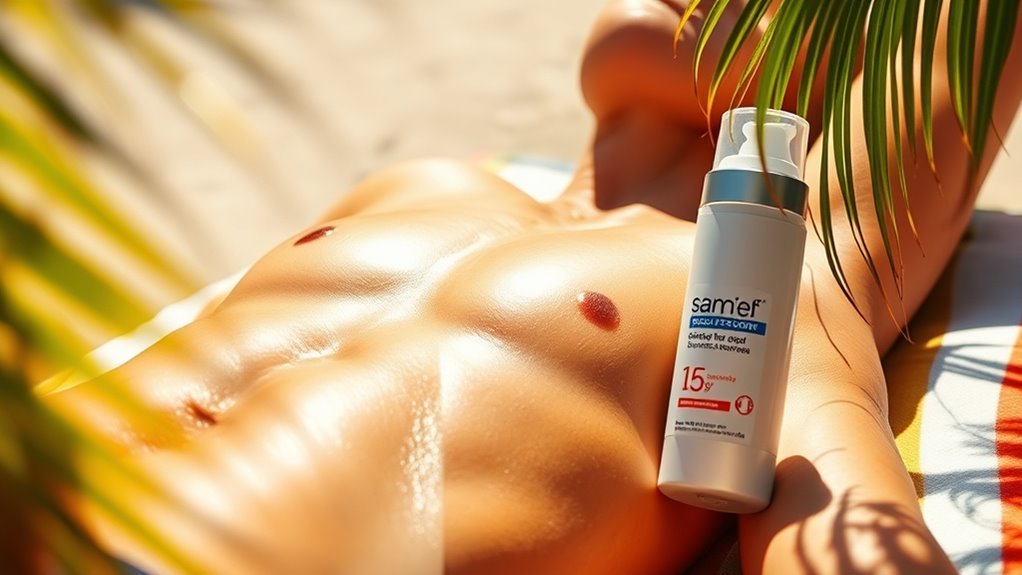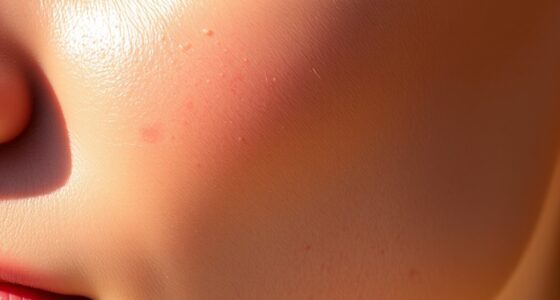Using sunscreen during tanning is essential because it creates a barrier that blocks or absorbs harmful UV rays, which can cause skin damage, premature aging, and increase your risk of skin cancer. Even if you want a tan, sunscreen helps prevent burns and DNA damage while still allowing you to enjoy the sun safely. Keep in mind that sunscreen alone isn’t enough—incorporate shade, clothing, and proper reapplication. If you continue exploring, you’ll discover how to tan more safely and protect your skin effectively.
Key Takeaways
- Sunscreen reduces UV radiation exposure, minimizing skin damage during tanning sessions.
- Applying broad-spectrum SPF 30+ sunscreen helps protect against UVA and UVB rays while tanning.
- Regular reapplication ensures continuous protection, especially when swimming, sweating, or towel drying.
- Tanning indicates skin injury and DNA damage, even with sunscreen use, emphasizing the importance of sun safety.
- Combining sunscreen with shade, clothing, and limited exposure offers the best protection during tanning.
Understanding Sunscreen and Its Role in Skin Protection
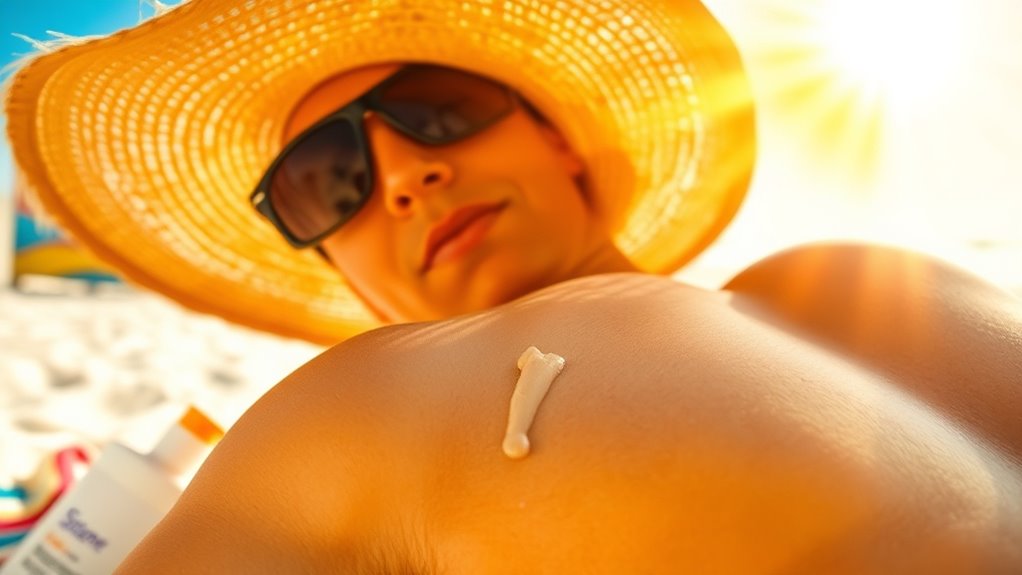
Sunscreen plays a vital role in protecting your skin from harmful ultraviolet (UV) rays. It works by creating a barrier that blocks or absorbs UV radiation from the sun, preventing it from penetrating your skin cells. This reduces the risk of sunburn, skin damage, and skin cancer. While no sunscreen offers complete protection, it extends the time you can spend in the sun safely. Different types contain ingredients that reflect, scatter, or absorb UV rays, with broad-spectrum options shielding against both UVA and UVB rays. UVB causes sunburn and DNA damage, so blocking it is essential. Applying sunscreen regularly, especially during tanning, helps preserve your skin’s health, prevents premature aging, and lowers long-term skin cancer risks. Remember, reapplication every 2-3 hours is necessary for continuous protection. Additionally, understanding the structure of the skin can help you appreciate how UV rays cause damage and why sunscreen is so important. Skin layers play a crucial role in how UV radiation affects different parts of your skin and highlight the importance of comprehensive sun protection. Recognizing the types of UV rays can further inform you about the specific threats they pose to your skin. Using sunscreens with added broad-spectrum protection can provide more comprehensive defense against various UV wavelengths.
The Myths and Realities of Tanning With Sunscreen

Many people believe that using sunscreen completely prevents tanning, but in reality, this isn’t the case. Sunscreen mainly blocks UVB rays, which cause burns, but UVA rays can still penetrate and stimulate melanin production, allowing you to tan. A tan isn’t a sign of safe sun exposure; it’s a sign of skin injury and DNA damage. Even with regular reapplication, you can still develop a tan, and the process indicates ongoing harm. Higher SPF doesn’t fully prevent tanning because no sunscreen blocks all UV rays. Remember, a tan—even with sunscreen—is a biological response to damage, not protection. Relying solely on sunscreen gives a false sense of security, so combining it with shade, clothing, and limited exposure is essential for safer tanning. Additionally, understanding the safety measures and proper application of sunscreens can help minimize skin damage while enjoying sunlight. Incorporating natural materials and mindful decor can also promote healthier skin habits by encouraging outdoor activity in shaded areas. Recognizing the types of UV rays involved can further improve your sun safety strategies. Being aware of UV exposure patterns can help you plan your sun protection effectively.
How Sunscreen Helps Reduce Skin Cancer Risks
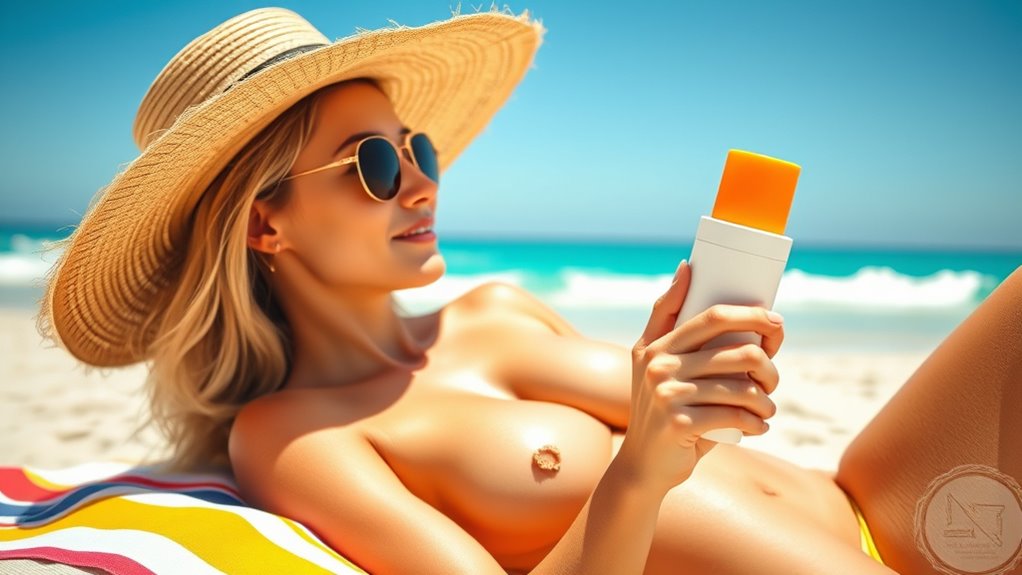
Using sunscreen consistently can significantly lower your risk of developing skin cancer by creating a protective barrier against harmful ultraviolet (UV) radiation. When you apply sunscreen with SPF 15 or higher, it absorbs or reflects UV rays, preventing them from damaging your skin’s DNA. This reduces the chances of developing skin cancers like melanoma and squamous cell carcinoma by up to 50% and 40%, respectively. Regular use also decreases precancerous lesions such as actinic keratoses, which can lead to more serious cancers. Sunscreen’s effectiveness is backed by numerous studies, including large trials showing fewer skin cancers among users. By limiting UV-induced cellular damage and slowing photodamage signs, sunscreen plays a vital role in lowering your long-term skin cancer risk. Additionally, incorporating sun protection like wearing eye patches can help shield delicate skin around the eyes from UV exposure, further reducing overall skin damage. Understanding the role of UV protection emphasizes the importance of consistent sunscreen application to prevent skin damage and cancer. Recognizing the importance of UV protection can motivate consistent and proper sunscreen use to maximize health benefits.
Selecting the Most Effective Sunscreen for Tanning
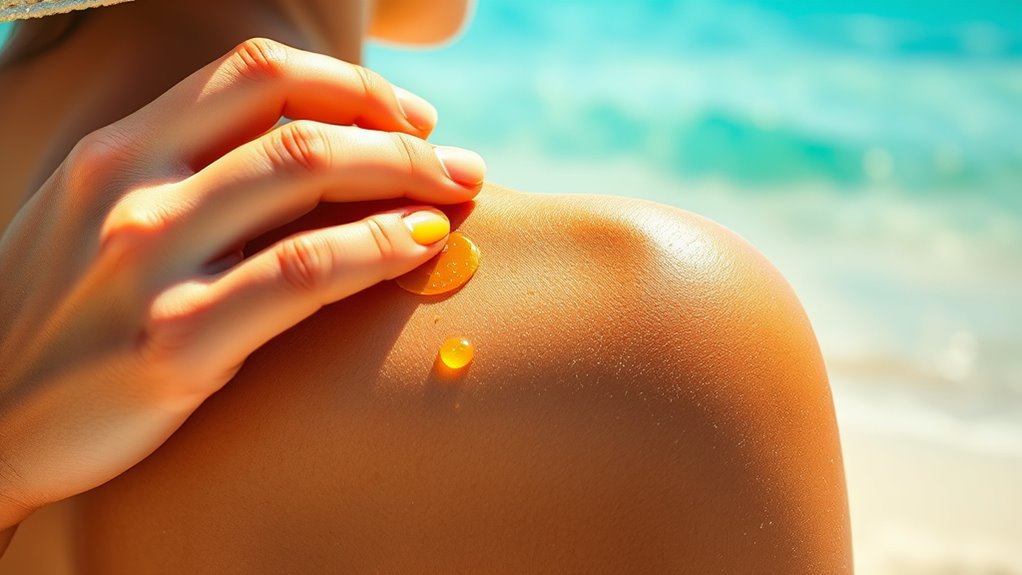
Choosing the right sunscreen for tanning involves prioritizing key features that maximize protection while allowing you to enjoy the sun safely. Look for sunscreens with SPF 30 or higher to block most UVB rays. Make certain it offers broad-spectrum protection against both UVA and UVB rays to shield your skin fully. Water resistance is essential if you’ll be swimming or sweating, maintaining protection during water activities. Consider products with moisturizing benefits, like those containing natural oils, aloe vera, or cocoa butter, to keep your skin hydrated. Non-comedogenic formulas prevent clogged pores, making them ideal if you’re prone to acne. You can choose from lotions for versatile protection, tanning oils with SPF for moisturization, or sprays for quick application. Always apply generously and reapply regularly to stay protected during your tanning session. Additionally, selecting appropriate sun protection helps prevent skin damage and supports long-term skin health. Utilizing sunscreens with known UV filters can further enhance your defense against harmful rays. Being aware of your skin type can guide you in choosing the most suitable product for your needs. Incorporating a personalized skincare routine tailored for sun exposure can also improve your skin’s resilience to UV damage. Understanding the role of sound design in media can even influence how information about sun safety is communicated visually and auditorily.
Risks of Tanning and Why Sunscreen Alone Isn’t Enough
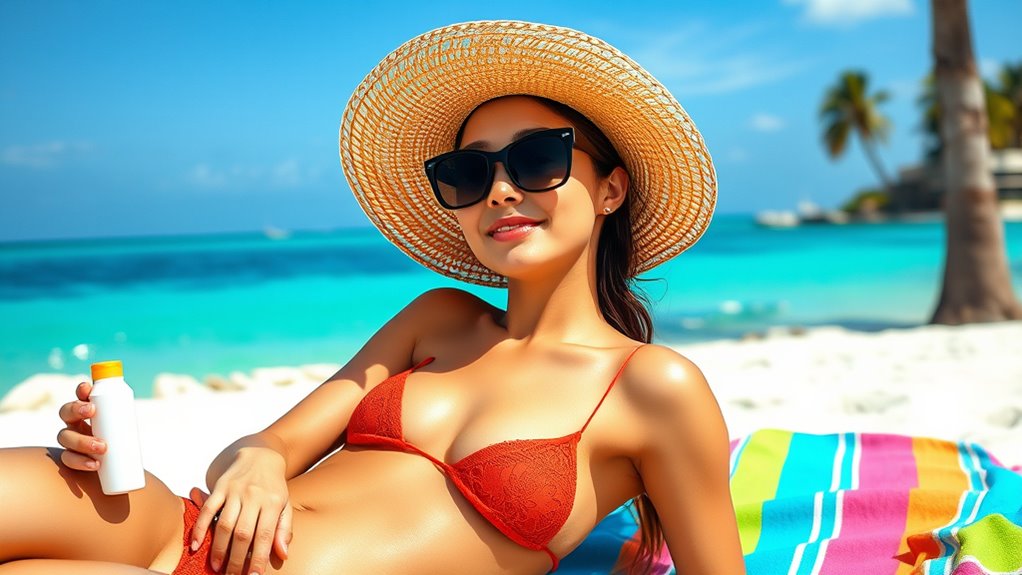
While applying sunscreen is essential, it isn’t enough to prevent the full range of risks associated with tanning. Tanning causes UV-induced DNA damage in your skin cells, increasing your risk of skin cancers like melanoma, basal cell carcinoma, and squamous cell carcinoma. Starting indoor tanning before age 35 raises melanoma risk by about 75%, and even occasional use increases the likelihood of skin cancer. A tan isn’t a sign of protection; it’s evidence of injury and DNA damage. Sunscreen, while helpful, can’t block all UV radiation or reverse existing damage. Improper application or failure to reapply reduces its effectiveness. Proper application techniques are vital to maximize sunscreen benefits and reduce skin exposure risks. Beyond cancer, tanning accelerates skin aging, causes immune suppression, and risks eye damage. The benefits of skin protection highlight the importance of protecting your skin from damage and the risks associated with tanning. Additionally, adopting comprehensive sun safety practices, such as seeking shade and wearing protective clothing, enhances your defenses against UV exposure. Regular use of effective filters can further improve your sun protection efforts.
Best Practices for Safe Tanning With Sunscreen
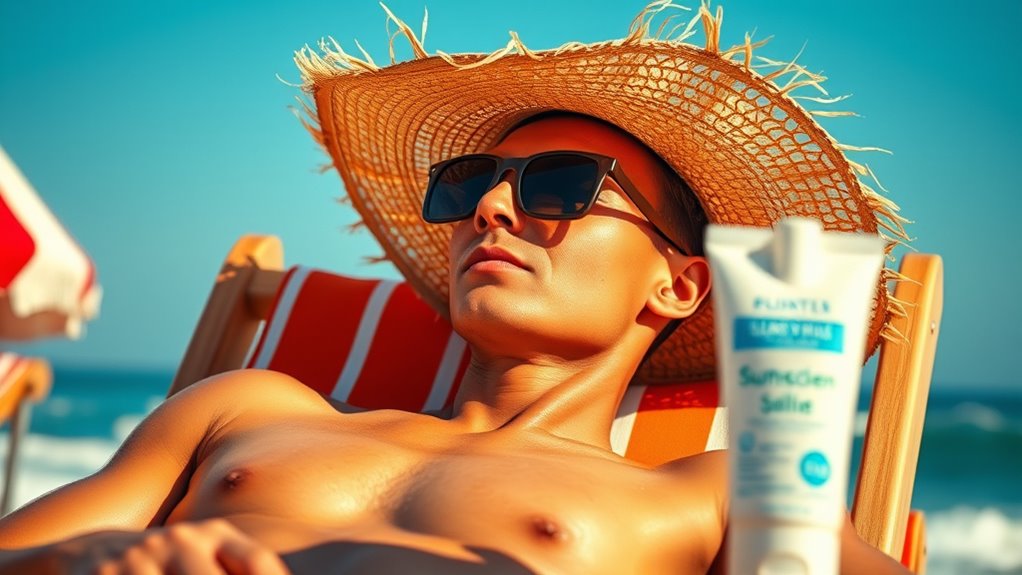
To tan safely with sunscreen, it’s essential to follow proper application and reapplication techniques that guarantee continuous protection. Apply broad-spectrum sunscreen with SPF 30 or higher at least 15 minutes before sun exposure, covering all exposed skin generously. Use about one ounce—a shot glass full—for full-body coverage. Reapply every two hours, or more often if you’re swimming, sweating, or towel drying. Don’t forget often-missed spots like ears, neck, feet, and backs of hands. Choose water-resistant formulations for active days and avoid flammable sunscreens near flames. Understanding industry trends can help you select the most effective products and techniques. Incorporating low light office plants can also improve indoor air quality and create a calming environment during your outdoor breaks. Staying aware of electric bike horsepower can inspire you to choose safer, more controlled activities in the sun. Regularly check your skin for signs of irritation or burns, and consider the latest safety guidelines to adjust your sun protection practices based on your skin type and activity.
Frequently Asked Questions
Can Sunscreen Prevent All Types of Skin Damage From Tanning?
Sunscreen can’t prevent all skin damage from tanning. While it helps reduce UV exposure and protect against burns and some aging signs, some rays still penetrate, causing tanning and damage. You might think higher SPF offers complete protection, but it doesn’t eliminate risks entirely. To best protect your skin, reapply sunscreen regularly, wear protective clothing, seek shade, and limit your sun time, especially during peak hours.
How Does SPF Influence Tanning While Using Sunscreen?
SPF influences tanning by determining how much UVB rays reach your skin. Higher SPF sunscreens block more rays, slowing down tanning but not preventing it entirely—SPF 50 blocks about 98%, so some rays still cause a tan. If you want a lighter tan or to protect your skin, choose a higher SPF and reapply regularly. Remember, even with high SPF, some UV exposure will still occur, leading to gradual tanning.
Is Water-Resistant Sunscreen More Effective During Tanning Sessions?
You might think water-resistant sunscreen is the best choice for tanning, but it’s only more effective if you’re active in water or sweating heavily. It helps maintain protection longer during these activities, reducing UV exposure. However, reapplication is still necessary every 40 to 80 minutes. While it offers better protection during water or sweat, no sunscreen is completely waterproof, so combining it with other protective measures is essential for safer tanning.
Does Applying More Sunscreen Increase Tanning Risk or Protection?
Applying more sunscreen doesn’t increase your tanning risk; it actually enhances your protection. When you use the recommended amount, you block most UV rays, reducing DNA damage and long-term skin harm. Under-application leaves patches exposed, increasing damage and potential tanning. Reapplying every two hours maintains protection, especially during sweating or swimming. Remember, no sunscreen fully blocks UV rays, so combining it with protective clothing and seeking shade further minimizes tanning risks and skin damage.
Are There Specific Ingredients Ideal for Tanning Protection?
You might think certain ingredients guarantee a perfect tan, but that’s a trap. Mineral sunscreens with zinc oxide and titanium dioxide are ideal because they reflect UV rays, protecting your skin while letting you enjoy your glow. They provide broad-spectrum coverage, especially against UVA rays that cause aging. Chemical filters can also help, but mineral options are safer and less irritating—making them your best bet for a safe, enjoyable tanning experience.
Conclusion
Remember, sunscreen is your shield in the sun’s fiery embrace, but it’s not magic armor. Think of it as your trusted guide, helping you dance safely under the blazing sky without getting burned or caught in harmful rays. By choosing the right sunscreen and following safe tanning practices, you’re painting a vibrant, healthy canvas—protecting your skin’s future while soaking up the warmth of the sun’s gentle kiss. Stay vigilant, stay radiant.
